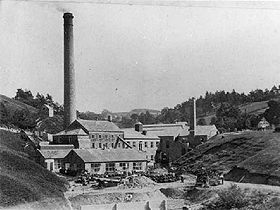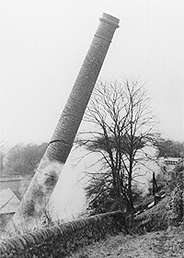Activities and information about Timbersbrook Picnic Area
The tall chimney of the Silver Springs Bleaching and Dyeing Works could be seen for miles around before it was demolished by Blaster Bates in 1966. Today Timbersbrook Picnic Area is a peaceful spot where families can picnic on the edge of young woodland.
Water from Timbers Brook was once used to power the silk mill and the old Mill Pool is now a locally important breeding pond for toads. Take care not to squash them as they cross the road in early spring! If you are lucky you may even see a Kingfisher or Heron silently waiting by the waters edge ready to pounce on any unsuspecting fish they spot.
Across the picnic area, steps go up to Tunstall Road and crossing the road here takes you to the path around one side of the Mill Pool and back out onto Tunstall Road.
The toilet block at Timbersbrook Picnic Area is unfortunately no longer open. There is no fishing on the Mill Pool.
Walking in Timbersbrook Picnic Area
The Gritstone Trail is a challenging 56km/35 mile route stretching from Disley to Kidsgrove. It runs through Timbersbrook Picnic Area, just follow the fingerposts and yellow waymark discs with a 'G' in a footprint. See the Gritstone Trail page for more information.
Following the Gritstone Trail across Weathercock Lane and the fields to the west of Timbersbrook will take you to the Biddulph Valley Way, a 6 mile multi user route which runs from just outside Congleton town centre to south of Biddulph. For more information on this route see the Biddulph Valley Way page.
Following the Gritstone Trail across the picnic area and up the steps onto Tunstall Road (shown by the Gritstone Trail fingerposts) will take you up to Bosley Cloud, where on a clear day there are brilliant views across Cheshire. For information on Bosley Cloud contact the National Trust.
OS Explorer maps are recommended to help you find your own routes and rides in the area. OS Explorer sheet 268 Wilmslow, Macclesfield and Congleton covers this area.
History of Timbersbrook Mill and the Silver Springs Bleaching and Dyeing Works
 Burdett's map of 1777 has an insignia showing a water wheel at Timbersbrook which may have powered one of the early silk mills using water power from Timbers Brook. By 1820 there were 33 silk mills working in the Congleton area. Timbersbrook Mill was used for silk throwing by a series of owners until the late 1800's when it was purchased by a Manchester businessman, Mr Thomas Royle.
Burdett's map of 1777 has an insignia showing a water wheel at Timbersbrook which may have powered one of the early silk mills using water power from Timbers Brook. By 1820 there were 33 silk mills working in the Congleton area. Timbersbrook Mill was used for silk throwing by a series of owners until the late 1800's when it was purchased by a Manchester businessman, Mr Thomas Royle.
In the early 1900's the Silver Springs Bleaching and Dyeing Company was set up, the abundance of pure clean water from Timbers Brook making it an ideal location for this industry. The name is thought to have come from Silver Springs in the USA, where the owner had been involved in an earlier enterprise. At about this time the mill was converted to steam power and later the 114ft chimney was constructed.
 Silver Springs employed over 200 people and was the main economic source for the immediate area. Its main job was to take rolls of unfinished cloth, mostly from the Manchester warehouses, bleach and dye them in a variety of finishes and colours, and either return the finished product to Manchester or export them. Thousands, if not millions, of yards of black cloth went to China from Timbersbrook.
Silver Springs employed over 200 people and was the main economic source for the immediate area. Its main job was to take rolls of unfinished cloth, mostly from the Manchester warehouses, bleach and dye them in a variety of finishes and colours, and either return the finished product to Manchester or export them. Thousands, if not millions, of yards of black cloth went to China from Timbersbrook.
The very first Foden commercial steam wagon was bought by Silver Springs in early 1902 to transport the cloth to and from Manchester. Later that year a second Foden steam wagon was purchased and the two of them did the Manchester run on alternate days, leaving at 4am and returning at 8pm.
Electrification of the mill took place in 1933 but trade was difficult in the 1930's and Silver Springs went into receivership at one point though it managed to survive. Although many yards of black out material were dyed in 1939, work dried up at the start of the Second World War. The receiver was called in again in 1942 and later the firm was sold to the Yorkshire Dyeing and Proofing Company.
In 1961 the mill finally closed and in 1966 the chimney was demolished by Blaster Bates. Congleton Borough Council purchased the site in 1975 and cleared it to create Timbersbrook Picnic Area which opened in 1980.
The information above has been gained from:
- Ross Mason. 2005. The History of the Cloud and Timbersbrook.
- W Ray Bossons
Countryside Ranger Service - Cheshire East Council
Contact Ranger service
rangers@cheshireeast.gov.uk
For Middlewood Way, Jacksons’ Brickworks, Poynton Coppice and Poynton Park: phone 01625 383700
For Tegg’s Nose Country Park: phone 01625 374833
For Lindow Common or Macclesfield Riverside Park: phone 01625 374790
For Brereton Heath Local Nature Reserve, Dane-In-Shaw Pasture SSSI, Croxton Park, Biddulph Valley Way, Timbersbrook Picnic Area, Salt Line, Borrow Pit Meadows and Rode Heath Rise: phone 01477 534115
For Astbury Mere Country Park, Merelake Way and Wheelock Rail Trail: phone 01260 297237
For Gritstone Trail: phone 01270 686029
Page last reviewed: 27 September 2022
Thank you for your feedback.